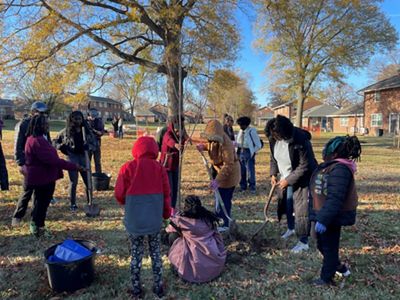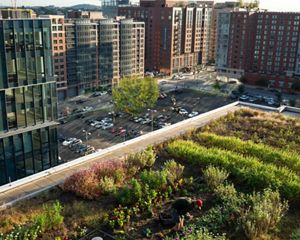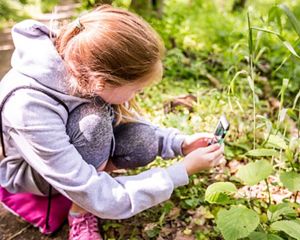
Baltimore’s Turner Station Neighborhood Gets New Tree Planting and Public Art Installation
New landscaping features were inspired by designs created by local scouts.
Media Contacts
-
Matt Kane
Phone: 323-898-6510
Email: matthew.kane@tnc.org
Baltimore’s historic Turner Station neighborhood celebrated a new tree planting and public art project inspired by designs created by local girl and boy scout troops with a community event on Sunday, November, 24. Girl Scout Troop 353 and Boy Scout troop 270 joined the Turner Station Conservation Teams and the Maryland/DC chapter of The Nature Conservancy (TNC) to celebrate the new additions, which include 45 new trees, four insect sculptures designed by artist Saba Hamidi, a new sign and four new stone walls that will provide additional public seating and include several small built-in “fairy houses” for children’s play.
“Our scouts love being outdoors and surrounded by nature,” said Girl Scout Troop 353 leader Arkia Wade. “It’s so important for these young leaders to be exposed to new paths—ones that they might not encounter in school—and to see that their ideas can shape the world around them. This spring the scouts learned essential skills—how to collaborate, how to make decisions collectively and how to bring their shared vision to life. We may have a future architect or landscape designer among us because of this experience.”
The scout troops participated in a four-part workshop series focused on developing practical skills in landscape design and conservation, which were co-facilitated by TNC design and engagement staff and consultant EnviroCollab earlier this year. The scouts helped choose native trees and created playful landscape models with craft supplies. Landscape architects took inspiration from the scouts’ models and created designs for new features that can help facilitate outdoor play for youth in the Turner Station neighborhood. Many of the new trees will also produce fruit or nuts which the local community or local wildlife can make use of. The trees were planted by Wright Environmental & Land Services, LLC, the new stones walls built by Live Green Landscape Associates, LLC, and the sculptures were fabricated by Novak Birch.

“Our decision to focus on youth engagement for the second Witness Trees project in Turner Station evolved out of conversations with community leaders and residents who have been interested in expanding opportunities for youth to shape the future of their neighborhood,” said Andrea van Wyk, Baltimore Community Project Manager for The Nature Conservancy. “That is why we partnered with the Turner Station Scouts on a community-based project that could help them envision what the future of their community could look like and how their ideas could be brought to life.”
Additional funding for the project was provided by Shared Earth Foundation, Tradepoint Atlantic through the Chesapeake Bay Trust, Baltimore Gas and Electric, the Bunting Foundation, the France-Merrick Foundation, and the Maryland State Arts Council.
This latest tree planting follows the planting of 140 trees and the installation of public art in Turner Station in 2022, as part of the first Witness Trees project. This project is part of TNC’s equitable urban forestry strategy, which is supporting the state of Maryland’s Tree Solutions Now Act, which aims to plant 500,000 trees in urban underserved areas by 2031. TNC is actively exploring opportunities to expand this initiative into other neighborhoods in Baltimore city and Baltimore County.
Turner Station is a low-lying, historically African American community in Baltimore that was founded during segregation in the 1880s, and has been home to many notable figures, including Henrietta Lacks. In 2001 long-time community members founded the Turner Station Conservation Teams, a non-profit organization committed to preserving and restoring the community’s health and heritage.


“As The Nature Conservancy expands our equitable urban forestry work to other communities in the region, many of which have similar histories and experiences to Turner Station, we will continue to center collaboration and authentic engagement as a precursor to tree planting,” said Isaac Hametz, Baltimore Program Director for TNC. “We know trees alone are not enough and we are committed to finding creative opportunities—including through art and design—for people to shape the future of their environments, so we can all live in a world where people and nature thrive together.”
The Nature Conservancy is a global conservation organization dedicated to conserving the lands and waters on which all life depends. Guided by science, we create innovative, on-the-ground solutions to our world’s toughest challenges so that nature and people can thrive together. We are tackling climate change, conserving lands, waters and oceans at an unprecedented scale, providing food and water sustainably and helping make cities more resilient. The Nature Conservancy is working to make a lasting difference around the world in 83 countries and territories (39 by direct conservation impact and 44 through partners) through a collaborative approach that engages local communities, governments, the private sector, and other partners. For more news, visit our newsroom or follow The Nature Conservancy on LinkedIn.





